Table of Contents
Anthracite
Although the unmined anthracite will last for approximately 150 years, most of the thicker and cleaner coal beds have been almost entirely first-mined and pretty well robbed, leaving much of the present and future production to come from thin and dirtier beds. Herewith is a section of one of the dirty beds being mined in the Wyoming region
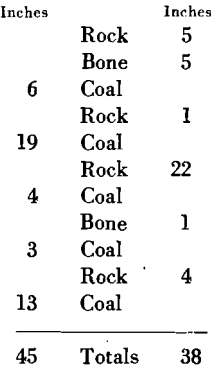
Impurities consist of fire clay, slate, rock, and bone. The latter, which is black, contains 40 to 60 per cent carbon and often resembles good coal. In some beds there are also bands of “blue” coal, which, as the name implies, is of a bluish slatey color. Although much of this “blue” coal has a carbon content almost as high as the good anthracite, it is not acceptable because of its dull appearance and therefore generally is gobbed.
Effect of Blasting Practices on Size in Run-of-mine
Many local areas of coal pillars were badly crushed by improper mining years ago. In recent years a repetition of such crushed conditions in other areas has been prevented by leaving in place large pillars of coal and columnizing the pillars in the various coal beds during first mining and also by carrying out orderly robbing. A further precaution has been the establishment of extra large pillars, at least 100 ft. wide, by not mining each tenth chamber.
Many anthracite workers who are certified miners are merely “blasters,” for such men do not use their past training, common sense, or instructions while drilling their holes and in choosing the amount and kinds of explosives used, with the result that much of the coal is unnecessarily blown to bits. This blasting abuse was recognized years ago and some of the anthracite companies, in order to overcome this wasteful practice, conducted numerous tests throughout the various sections of the mines to determine the best blasting practice for each mining condition. These preliminary tests to determine the best one for each condition included location, angle, depth of the drill hole, and kind and amount of explosive. The test that produced the highest percentage of large sizes of coal with the least amount of drilling and explosive was adopted as the guiding or best practice for that particular mining condition. All the facts in connection with each adopted best practice were printed in small pamphlets, copies of which were distributed to the miners working in that particular condition. The supervisory official, who helped conduct the tests, then explained all the details to the miners and supervised the application of the adopted practices. Virtually all of these best practices showed a saving in both labor and the amount of explosive used and thus gave an incentive to the miners to follow such practices. The adoption of these best blasting practices increases the percentage of lump coal, but such improvement continues only as long as their application is followed up daily by the officials in charge, and also by change in the adopted practices as the mining conditions change.
Effect of Undercutting on the Sizes in Run-of-mine
The use of the undercutter makes it possible to produce coal with a smaller number of drill holes and a considerably smaller amount of explosive, which gives a higher percentage of large sizes. Many run-of-mine sizing tests have shown that undercut coal gives at least 10 per cent more chunks than shooting off the solid, in spite of the fact that the undercuttings produced by the machines contain a high percentage of fines.
The sizes in the undercuttings can be increased by using harder cutting bits. The bits may be made harder by tipping them with abrasion-resistant substances such as borium and tungsten carbide.
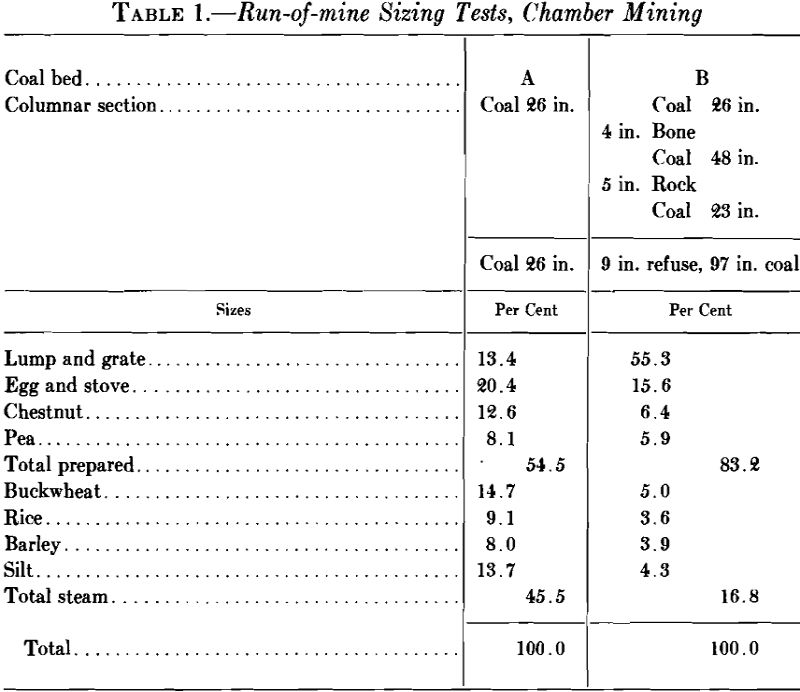
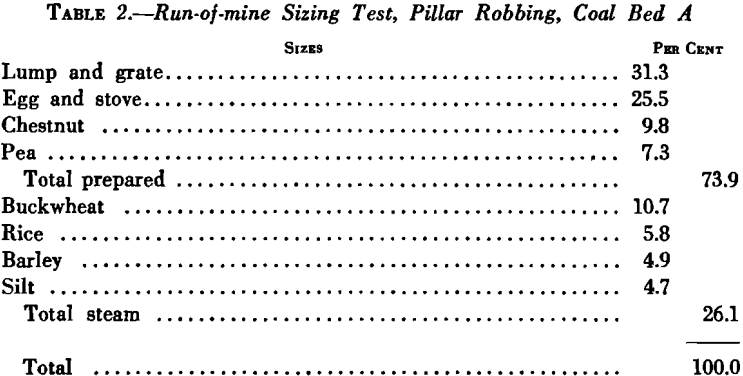
Effect of Mechanical Loading on Refuse in Run-of-mine
As mechanical loading has been adapted to almost all conditions in the anthracite region except crushed and pitching coal beds, the various blasting practices heretofore mentioned have their part in cleaning the coal of refuse at working faces from which coal is loaded mechanically.
The scraper was the first generally adopted mechanical loading method in the anthracite region. In this system, immediately after the coal is blasted the men begin to gob the visible refuse from the loose coal at the location from which loading is to begin. As the loading continues and props are stood, the two or three men at the face continue to gob visible refuse. While the scraper is going back and forth between the face and the car is being loaded, hand picks are used by the men at the car to turn over the coal, looking for refuse.
Where large pillars are being robbed by taking cuts across the back ends, and no props have been shot out, it is the practice to gob all visible refuse from the blasted coal before loading starts. Then, as loading proceeds, the men at the face continue to search and watch for refuse, which they gob.
Bituminous
The preparation of bituminous coal for market begins underground at the “working face.” It involves the selection of those portions of the bed considered merchantable and applicable to predetermined markets, the maintenance of uniformity in chemical quality, the elimination of removable impurity, control of sizes and size ratios, and control of moisture. The methods employed to attain these objectives vary widely with the beds under development, with the mining equipment available, and with changing trends in the consuming markets.
Chemical Quality
The quality of coal as determined by chemical analysis is without question one of the most important considerations in the development and life of any coal-mining property. Variations in volatile matter, ash and sulphur content, ash-fusion temperature and to a limited extent phosphorus, pyritic sulphur, and iron oxides classify coals in their adaptability for specific uses, and maxima and minima of ash and sulphur content established by competitive market conditions have placed definite limits on the marketability of all coals.
The prospecting of any area containing one or more merchantable coal beds, by means of channel samples taken from outcrop openings and from diamond-drill cores, yields valuable data on quality characteristics. When channel samples and drill cores are sectionalized to indicate the quality of individual stratifications of the bed, the mining methods to be employed to yield a certain quality of product may be determined in advance of development, since there are few coal beds known today that do not show wide horizontal variations in ash and sulphur content throughout the geographical area in which they occur, and in the portions of the bed between roof and pavement as well. Selective mining by areas is practiced within the producing area of any given mine by sections, and occasionally by segregation of the production from individual working places.
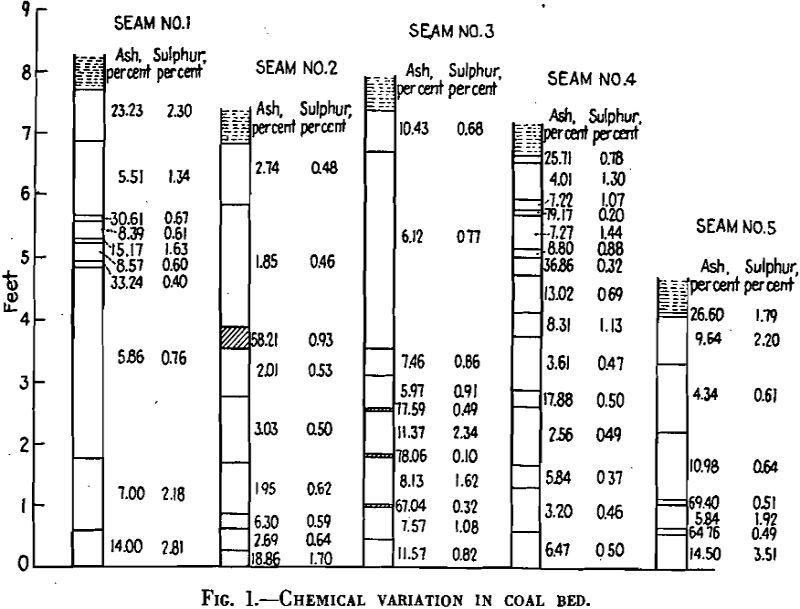
This system is most successful where two miners are assigned to each working place, loading simultaneously, one from the top bench and one from the bottom at opposite sides of the mine car. Where mechanical loading units are employed control is less positive, although it is common practice to shoot a cut of coal down or up in its entirety, obtaining a mixture of the various sections of the bed. The loading of two benches of coal separately with mobile loaders is not generally considered practical.
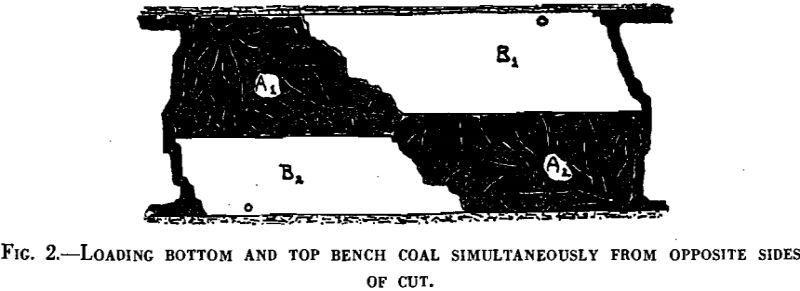
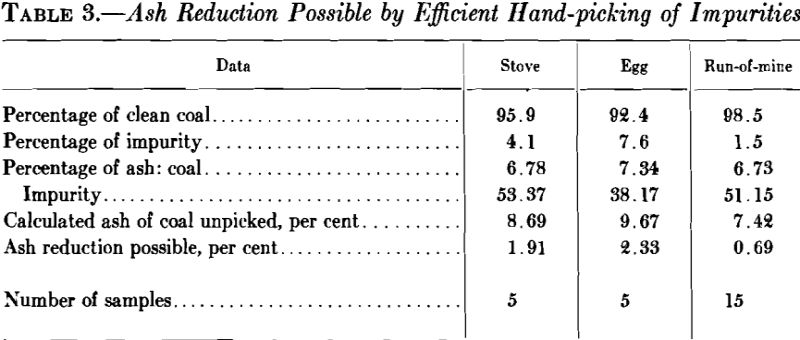
Visible Cleanliness
“Cleaning of coal at the face” means the removal of a visible impurity. Impurities may occur as well-defined partings, varying in thickness, in character, in hardness and in regularity. They may consist of the more prominent irregularly occurring clay veins, niggerheads, sulphur balls, the vertical ironclads of the Pittsburgh bed, pyrite, pockets, and streaks of hard, sulphury mother coal. There are also the less distinguishable “bone” bands, which may occur in any part of the bed, though found more frequently near the top or the bottom.
The secondary source of impurity is the medium surrounding the seam; that is, the roof and the floor or pavement. The softer the material composing either, and the more irregular its structure, the more difficult the problem of preventing contamination of the coal at the working face during mining. Frequently it has been found necessary to leave part of the bed at the top to form a coal roof and part of the bottom of the bed to serve as a floor. Sometimes this may coincide with the elimination of an undesirable portion of the bed, as well as being a desirable safety precaution.
In pillar work, cutting machines often cut through ribs into falls or gob, dragging variable quantities back into the cut and mixing with cuttings.
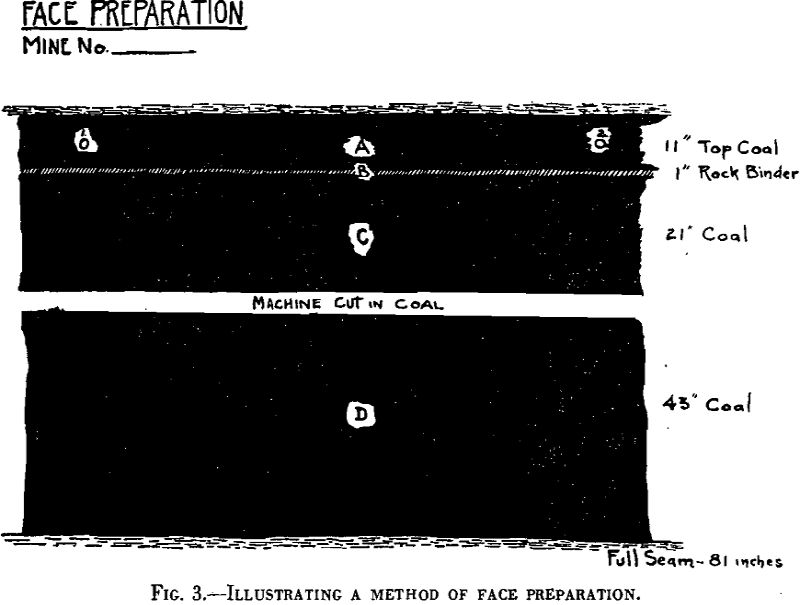
Procedure
- Cuttings cleaned from kerf and loaded up.
- Top drill holes both shot lightly.
- Top coal above binder mined out and loaded.
- Binder removed uniformly from rib to rib, front to back.
- Bottom holes shot as heeded.
Bad roof conditions, whether natural or induced by inefficient mining, are often cited as the excuse for poor results on face cleaning. Poor roof does constitute a problem from the standpoint of safety as well as cleaning, but when special attention and added precautions are taken, results are generally quite satisfactory.
Numerous factors affecting the performance of the miner in removing bed impurities at the face include size, contrast and conspicuousness; tendency of impurities to separate from the coal or remain “frozen” and their occurrence scattered throughout the bed or concentrated in certain sections thereof. Poor eyesight, coupled with unfamiliarity and inability to distinguish coal from impurity on the part of the individual miner cannot be expected to yield satisfactory results. Indifference and vindictiveness on the part of the miner, prompted by unsatisfactory wage scales and reject clauses, have frequently been responsible for poor results.
Where thick partings are undercut, holes are drilled in the slate or in coal at the top of the parting, which is then broken down by blasting with a permissible gelatin explosive. It can then be removed from the cut by hand, or, more economically, by dragging with a suitable cutting machine.
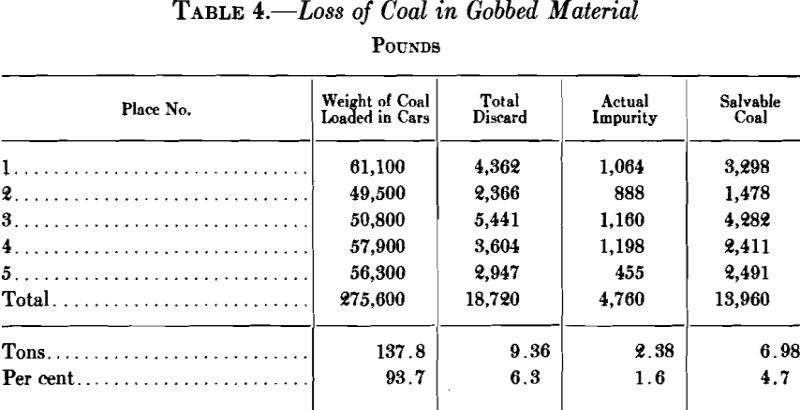
Control of Sizes
Characteristics of structure and hardness inherent in the different beds are initially responsible for variables in the percentage of merchantable sizes produced. Low-volatile coals in the bituminous group are universally softer and weaker in structure than higher-volatile coals. Hardness and density of structure also seem to increase with the inherent ash content.
Even within each bed, individual benches and stratified layers show widely varying characteristics of structure and hardness. Pick miners have always taken advantage of bed characteristics to place their “mining” in the softest portion, as in the “mining ply” of the Georges Creek, Big Vein bed in Maryland. In some beds machine cuts are made in the softest part. Some beds show marked lines of cleavage, with well-defined “faces” and “butts,” which must be taken into consideration when mine projections are established. Some sections of individual mines may even show weaker structure than others, yielding what is commonly known as “friable” coal, which is objectionable to the dealer trade. Individual beds generally show firmer structure and resistance to degradation in areas where the cover or overburden is the lightest. Mines that have workings above drainage levels also encounter along their outcrop lines more or less stained coal and coal of weaker structure.
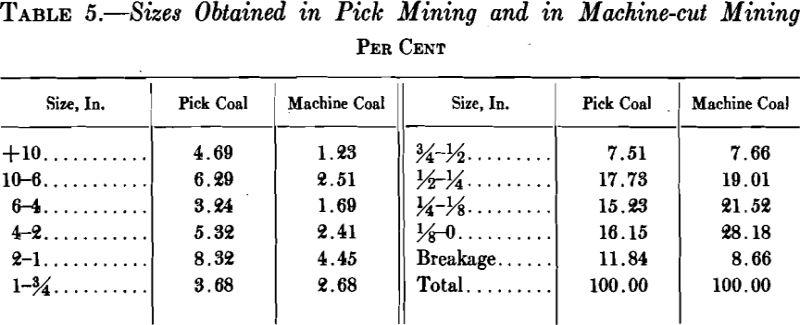
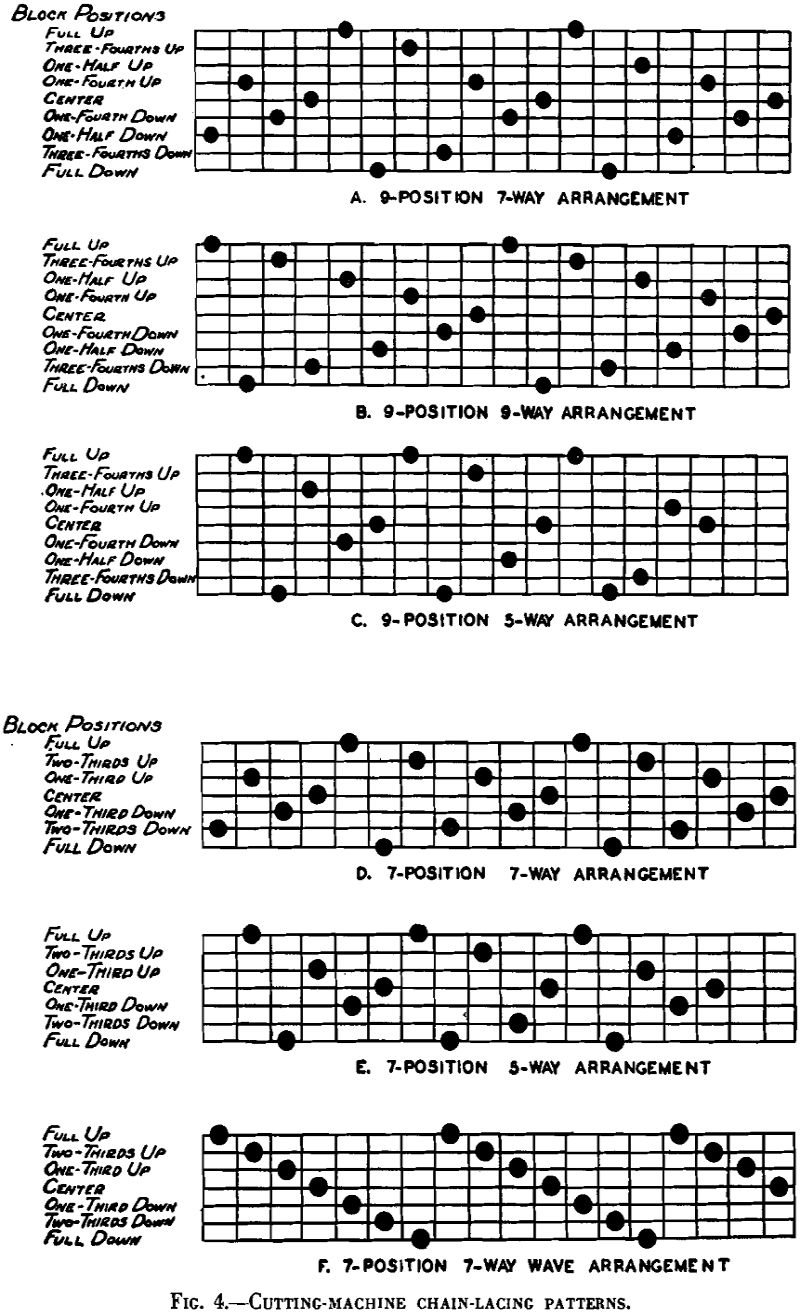
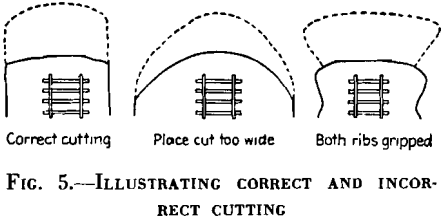
The round for drilling the working places in any mine must be worked out by actual practical tests underground. The number of holes, their spacing, location and distance from the ribs cannot be determined in any other manner, although experience in the mining field may be used as a guide. Drilling holes level, or nearly so, parallel with the ribs and laterally in the same bedding or cleavage plane, not closer than 6 in. to the solid, is considered good mining practice. The diameter of the holes must necessarily be larger than the diameter of the explosive cartridge in use; a minimum of ¾ in. latitude has been generally accepted by the industry as sufficient to meet most requirements. The tendency of miners and others to follow the rib line of a cut in angling drill holes invariably leads to inferior blasting.
Control of Moisture
The moisture content of coal may be a negligible quantity to many consumers and producers, but to some it is of prime importance. Industrial consumers who use large quantities of run-of-mine or slack sizes dislike paying for excessive water and the freight charges thereon. Some of the coal purchased must also be used to evaporate this excess moisture. Many modern steam-plant installations have been made in recent years to burn pulverized coal. Moisture interferes with pulverization to such an extent that dry coal is especially selected for many such consumers, and the railroad cars containing their coal are covered with tarpaulin or tar paper securely fastened for protection from rainfall while in transit. Wet coal will freeze solid in the hopper pockets in the northern areas during the winter season and give trouble, in unloading.
Extraneous Impurities
Foreign material, consisting of tramp iron of all kinds, pieces of wood of all sizes, exploder wires, used tamping, occasionally explosives and exploders, rock dust, pieces of brick and tiles, is introduced largely through carelessness or indifference of the mine organization—principally the miner. The coal producer cannot possibly be held accountable for stone and foreign matter thrown on loaded coal cars in transit between mine and destination as long as coal is shipped in open-top cars, but there is no excuse for such material of mine origin in a consumer’s bin.
The commonest items of tramp iron are machine bits, some broken off as a result of faulty tempering during sharpening, some merely pulled out of the chain lugs during cutting because of defective set screws. Track spikes and bolts, angle and splice bars are either dropped, carelessly handled or hidden near the faces and ribs, and eventually become mixed with face coal. Miners chop posts and cap boards in their working places and, unless instructed otherwise, are indifferent toward the elimination of chips, bark, and prop ends. Cap boards are often used to cover holes in mine-car sides, ends and bottoms. Where conveyors are used, chain parts and flights are misplaced frequently near the face while extensions are being made.

